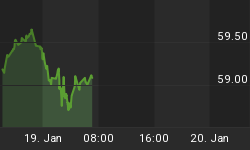The debate rages on in the financial press as to whether the U.S. is in a bear market or a bull market. But the obvious fact that has escaped all too many commentators is that we are actually in the midst of what I call a "fear market."
As the name suggests, fear markets are characterized by extreme manifestations of fear and concern among investors, both bulls and bears alike. By their very nature, fear markets tend to produce more upside moves in stock prices than they do downside moves. This is because the stock market operates on the contrarian principle so that whenever too many investors becomes fearful, the market goes up, while when the majority become greedy, the market turns down. The old saying on Wall Street is that the market climbs a proverbial "Wall of Worry." This is very true. Fear markets beget market rallies, and at the very least act to prevent serious declines.
How fearful is the market right now, you ask? Here's a small sampling of headlines from the past week:
"Dow loses fizz to close below 10,000" (front-page article in London Financial Times), "Selling fever pushes Footsie to year-low," "Fears grow over futures earnings," "Technology jitters spread through region," "Cautious guidance sets the scene for bearish Wall Street," "Technology stocks tumble on fears of downturn in chips," and "Terrorist threat looms."
On July 19, the America Online news headline service ran an in-depth financial article from the Dow Jones Newswire with the following headline: "Are your investments at risk?" The article began, "After a year of stellar gains, stocks are widely expected to post flat to low growth. Interest rates are likely to rise over the next few years, meaning even more uncertainty for stock investors and bondholders. And the higher cost of everything from gasoline to milk has raised the specter of inflation."
In one sentence this major mainstream news source covered the three dominant feelings of the day in the world of finance, viz., declining stocks, rising interest rates, and rising inflation. Are these fears valid? Whenever I read a headline like this in the mainstream press I am reminded of a statement in a book written many years ago by Michael Scott, who invented Scott's Law, which is: "The credibility of any item in finance is inversely proportionate to the amount of publicity it receives."
Let's ask ourselves a question. Has the bearish case for stocks and the economy received more than its fair share of publicity in recent weeks? Without question! Draw your own conclusion.
I was taken aback by the latest front cover of the August 2004 issue of Futures magazine. It has a dark overtone with the headline, "Stock Market Smackdown" and featuring a snarling bear with its claws exposed. The gist of the feature article is that there is a rather intensive battle currently underway between the bulls and bears with many conflicting technical and fundamental signals to support either case. Why the confusion? I attribute it to the 10-year cycle, since the larger 20-year cycle is peaking while the 10-year cycle is bottoming this year. Also, the 4-year cycle is still peaking which only creates more cross-currents. If the 10-year cycle were coming down alone, or with other cycles on top of it, year 2004 would undoubtedly have been a very bearish year. But to date we've had a net trading range with little in the way of sustained movement in either direction, to wit, a deadlock.
 For the bears to succeed in re-establishing a longer-term bearish trend they should have taken control by now, which they've been unable to do. The 10-year cycle low is due by late September/early October, and if they can't crack the market severely between now and then, then they will have lost their last chance, for heading into the 2005-2009 time frame there is no major long-term cycle due to peak or bottom until 2010-2014. And as history proves, there has never been an X-5 to X-9 time frame in the past 100 years that has been net bearish in the stock market. Why the bears persist in bucking the clear pattern of history is beyond me.
For the bears to succeed in re-establishing a longer-term bearish trend they should have taken control by now, which they've been unable to do. The 10-year cycle low is due by late September/early October, and if they can't crack the market severely between now and then, then they will have lost their last chance, for heading into the 2005-2009 time frame there is no major long-term cycle due to peak or bottom until 2010-2014. And as history proves, there has never been an X-5 to X-9 time frame in the past 100 years that has been net bearish in the stock market. Why the bears persist in bucking the clear pattern of history is beyond me.
Turning our attention back to the short-term, according to Stock Trader's Almanac (STA), harvest time in the agrarian economy of the early 20th century made August the best month of the stock market from 1901-1936. Since that time, however, August has become the worst month in the past 15 years for the Dow and S&P, and the second worst on the NASDAQ (although the NASDAQ was up 11.7% in 2000). The best Dow gains in August were in 1982 (+11.5%) and 1984 (+9.8%) as bear markets ended.
According to STA, however, there is an exception to the negative August historical pattern: an election year! August in an election year tends to do much better than non-election year Augusts, says STA, and they ranked #2 for the NASDAQ (average gain 3.5%). The average August election year gain for the S&P is 1% (up 7, down 6). STA further points out that the market tends to do well in August when an incumbent is running in the election.
















